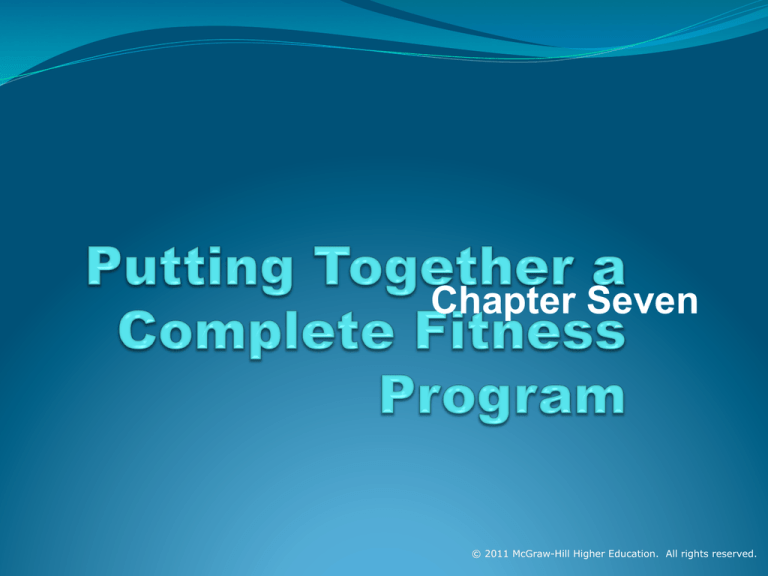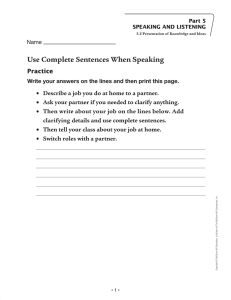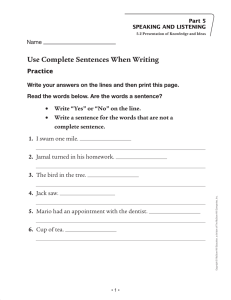
Chapter Seven
© 2011 McGraw-Hill Higher Education. All rights reserved.
Developing a Personal
Fitness Plan
1. Set goals
2. Select activities
- 5 Fitness components
3. Set a target
frequency, intensity,
and time (duration)
for each activity
4. Set up a system of
mini-goals and
rewards
5. Include lifestyle
physical activity in
your program
6. Develop tools for
monitoring your
progress
7. Make a commitment
2
© 2011 McGraw-Hill Higher Education. All rights reserved.
Developing a Personal Fitness
Plan
3
© 2011 McGraw-Hill Higher Education. All rights reserved.
Set Goals
Ø Develop different types of goals
General and specific
Ø Long-term and short-term
Ø
Ø Having specific goals helps to track your progress and
enjoy the measurable changes brought by the fitness
program
Ø Also, use physical fitness assessments to determine
your goals
Ø They help to decide what types of exercise is more
important than others
4
© 2011 McGraw-Hill Higher Education. All rights reserved.
Select Activities
Activities should reflect each component from health-
related fitness, such as:
Cardiorespiratory endurance
Muscular strength
Muscular endurance
Flexibility
Body composition
Also consider these factors:
Fun and interest
Your current skill and fitness level
Time and convenience
Cost
Special health needs
5
© 2011 McGraw-Hill Higher Education. All rights reserved.
Set a Target Frequency, Intensity, and
Time for Each Activity
Apply the FITT Principle to set up a starting frequency,
intensity and time component for each prescribed activity
Refer to Figure 7.1 and 7.2 to program for these areas:
Cardiorespiratory endurance exercise
Muscular strength and endurance training
Flexibility training
© 2011 McGraw-Hill Higher Education. All rights reserved.
A summary of the FITT principle for the healthrelated components of fitness
7
© 2011 McGraw-Hill Higher Education. All rights reserved.
Set Up a System of MiniGoals and Rewards
Ø To stay on track, it is important to set up a system of
goals and rewards
Ø Break your specific goals into several steps
Ø Set a target date for each step
Ø Realistic goals broken into achievable mini-goals can
boost your chance for success
8
© 2011 McGraw-Hill Higher Education. All rights reserved.
Include Lifestyle Physical Activity in
Your Program
Ø Daily physical activity is an important part of a fit and well
lifestyle
Ø Find methods to become more physical in your daily
routines
Ø Use your health journal to track your activities for several
days
Ø Review your records and identify routine opportunities to
become more active
9
© 2011 McGraw-Hill Higher Education. All rights reserved.
Develop Tools for Monitoring
Your Progress
Ø Recording your daily progress helps remind you of your
commitment to your program and gives you a sense of
accomplishment
Ø Post your log in a place where you will see it often as a
reminder and incentive for improvement
Ø Compare your results over time, preferably every 3
months
10
© 2011 McGraw-Hill Higher Education. All rights reserved.
A Sample Program Log
11
© 2011 McGraw-Hill Higher Education. All rights reserved.
A Sample Program Progress Chart
12
© 2011 McGraw-Hill Higher Education. All rights reserved.
Make a Commitment
The final step in planning your program is to make a
commitment
Signing a personal contract is a way to accomplish this
Find a witness for this contract, preferably one who will
be involved in your fitness program
Keep your contract in a visible spot as a reminder of your
commitment
© 2011 McGraw-Hill Higher Education. All rights reserved.
Putting Your Plan into
Action
Start slowly and increase
Cycle the duration and
fitness gradually
Find an exercise buddy
Ask for support from
others
Vary your activities (crosstraining)
intensity of your workouts
Adapt to changing
environments and
schedules
Expect fluctuations and
lapses
Choose other healthy
lifestyle behaviors
14
© 2011 McGraw-Hill Higher Education. All rights reserved.
Maintaining Your
Program: Fit For Life
Be safe
Have several exercise options
Keep an exercise journal
Reward yourself
Choose other healthy lifestyle behaviors
15
© 2011 McGraw-Hill Higher Education. All rights reserved.
Exercise Guidelines for
Life Stages
Children and Adolescents
Pregnant Women
Older Adults
16
© 2011 McGraw-Hill Higher Education. All rights reserved.
Chapter Seven
PUTTING TOGETHER A COMPLETE FITNESS PROGRAM 17
© 2011 McGraw-Hill Higher Education. All rights reserved.



